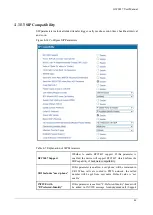
GW0017 User Manual
31
SIP Transport Type
The way of SIP-based transmission. It can be UDP, TCP, TLS or
Automatic. Default: UDP.
Use Random Port
If this parameter is selected, the local port of the GW0017 device
for using SIP services is chosen by random.
SIP UDP/TCP Local Port
The UDP/TCP port of GW0017 device for using SIP services.
Default SIP UDP/TCP local is 5060.
SIP TLS Local Port
The TLS port of GW0017 device for using SIP services. Default
SIP TLS local port is 5061.
Usually, SIP server does not participate in media process ing. Under SIP network, media
always use end-to-end negotiating. Simple SIP server is only responsible for the
establishment, maintenance and cleaning of sessions, while relatively-complex SIP
server (SIP PBX) not only provides basic calling and conversational support, but also
offers rich services such as Presence, Find-me and Music On Hold.
SIP server based on Linux platform, such as: OpenSER
、
sipXecx
,
VoS
,
Mera etc.
SIP server based on windows platform, such as :mini SipServer
、
Brekeke
,
VoIPswitch etc.
Carrier-grade soft switch platform, such as Cisco, Huawei, ZTE etc.
4.7
IP Profile
The device supports simultaneous registration to multiple SIP servers and making calls.
Different ports can be configured with different SIP server addresses and use different voice
codecs as needed. IP profiles are used to create SIP server addresses, proxy servers, dialing
rules, service parameters, dialing parameters, voice codec and other parameter configuration
for ports. When configuring the port, you can save the IP profile index and use it. For index
configuration, refer to the "Port " page.
When the device is only registered to one SIP server, the IP profile does not need to be
configured, and the default IP profile can be used. When the device needs to register to
multiple SIP servers, click the "Add" button to create a new IP profile, as shown in the figure
below:
















































